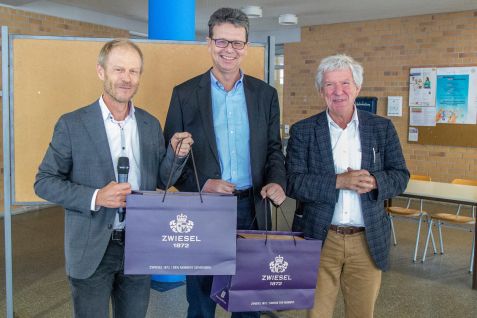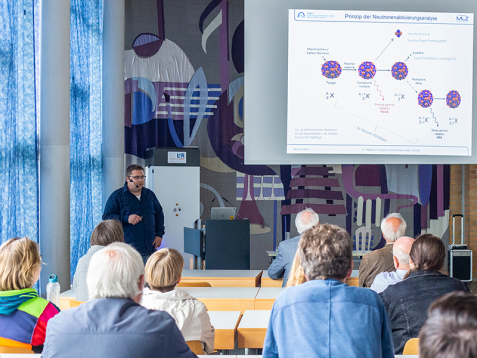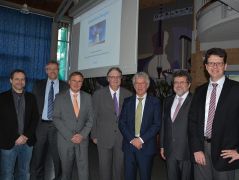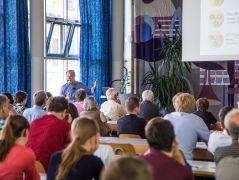MLZ is a cooperation between:
 > Technische Universität München
> Technische Universität München > Helmholtz-Zentrum Hereon
> Helmholtz-Zentrum Hereon
 > Forschungszentrum Jülich
> Forschungszentrum Jülich
MLZ is a member of:
 > LENS
> LENS > ERF-AISBL
> ERF-AISBL
MLZ on social media:

MLZ (eng)
Lichtenbergstr.1
85748 Garching
23.09.2022
On bodies and sky discs

Head of the school, Dr. Wolfgang Holzer, in Zwiesel thanked the academic directors of the Edgar Lüscher Seminar, Prof. Dr. Winfried Petry (r.), and Prof. Dr. Peter Müller-Buschbaum (M). © Gymnasium Zwiesel
The 44th Edgar-Lüscher Seminar attracted more than 50 teachers from all over Bavaria to Zwiesel from July 4 to 8. This year, the renowned training course followed “Physics in Archaeology and Art History” and dealt with the latest neutron methods in the examination of paintings by Van Gogh or the Nebra Sky Disk.
After a two-year break due to the pandemic, the important educational symposium finally took place as usual at the Gymnasium Zwiesel. This was possible thanks to the persevering cooperation between the school’s staff and the scientific heads of the Edgar-Lüscher seminar, Prof. Dr. Peter Müller-Buschbaum, scientific director of the FRM II and MLZ and his predecessor Prof. Dr. Winfried Petry. As in previous years, distinguished speakers held exciting presentations for the teachers in Zwiesel with a great turnout. Prof. Dr. Winfried Petry emphasized the importance of the seminar as it is designed to “refresh the teachers’ motivation, so that they can pass along the knowledge to their students.”
Bog bodies attract students
Around 50 teachers from all of Bavaria signed up for the event, with plenty of students being present at the introductory presentation as well, held by Dr. Andreas Kratzer of the Technical University of Munich on the topic of bog bodies, human remains found in moorlands. With the overarching theme of the seminar being physics in the context of archaeology and art history, Prof. Dr. Müller-Buschbaum provided the connection between the two areas of study – stating that physics has been the basis for groundbreaking discoveries made in the latter two fields – something which was illuminated over the course of eight presentations.

Dr. Christian Stieghorst, instrument scientist at MLZ, explained how neutron activation analysis works during his presentation to the teachers. © Gymnasium Zwiesel
Changed colors in a Van Gogh
One such talk, held by Prof Dr. Ina Reiche from the Parisian chemical institution ParisTech, dealt with non-invasive imaging- and analysis techniques in the examination of historical and prehistoric art works. With the help of the methods discussed, a research team led by Prof. Reiche was even able to restore a self-portrait of Gustav Courbet.
Intrigued listeners of Dr. Christian Stieghorsts’ presentation learned about how the place of origin of all types of archaeological finds can be determined via neutron activation. The chemical composition of probes can be discovered by being bombarded with neutrons, experiencing nuclear excitation, and releasing characteristic gamma rays. These results provide information about the ancient trade routes of Roman amphorae, for example.
Dr. Eberhard Lehmann of the Paul-Scherrer Institute in Switzerland presented another example for research using neutrons. Lehmann demonstrated to the public, through examples of all kinds of archaeological finds, just what kind of information can be gathered through neutron imaging.
The topic of a virtual presentation held by Prof. Dr. Matthias Alfeld of TU Delft was the analysis of artworks made possible by synchrotron radiation, with one notable example being the painting by Van Gogh, “The Bedroom in Arles”. X-ray spectroscopy reveals that the colors of the painting have changed over the course of time due to UV rays.
Discs and debates
A highlight and very much engaging part of the presentations took place during Prof. Rupert Gebhard’s, director of the Bavarian Archaeological State Collection, talk regarding the boundaries of science and the Nebra sky disc (see Story Archaeological sensation or brilliant deception”). Much discussion was had regarding this piece of history and its authenticity, with it proving to be a polarizing topic – inevitably engaging the bright minds present and driving the scientific discourse forward.
Andreas Kratzer demonstrated quantum physical experiments to interested students in the TUM Student Laboratory the week following the seminar, making it possible for additional schools to take part. With these experiments concluding this year’s event, the organizers look forward to next year’s 45th Edgar Lüscher Seminar during the 21-23 April 2023, with the topic of “Applied Quantum Physics”
More information:
Next Edgar Lüscher Seminar in Zwiesel on “Applied Quantum Physics” from April 21 to 23, 2023.
Information and registration via the website of the Gymnasiums Zwiesel, the website of the Chair of Functional Materials or the Bavarian Education Portal for Teachers under the keyword “Lüscher”.
Related News
-
17.04.2019
Energy for teachers
MLZ is a cooperation between:
 > Technische Universität München
> Technische Universität München > Helmholtz-Zentrum Hereon
> Helmholtz-Zentrum Hereon
 > Forschungszentrum Jülich
> Forschungszentrum Jülich
MLZ is a member of:
 > LENS
> LENS > ERF-AISBL
> ERF-AISBL
MLZ on social media:




